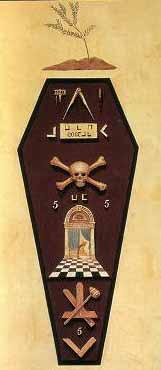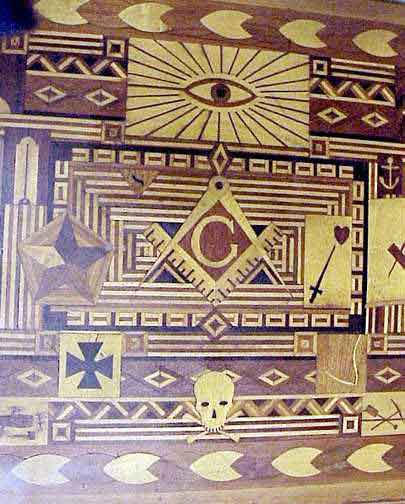
 From
time immemorial, mankind has pondered the amazing cycle of birth and death.
Approaching later years, it is only natural that one contemplates the
'hereafter' and the fact that life is, indeed, fleeting.
From
time immemorial, mankind has pondered the amazing cycle of birth and death.
Approaching later years, it is only natural that one contemplates the
'hereafter' and the fact that life is, indeed, fleeting.
In a world where life seems exceptionally cheap and people are willing to give their lives for a cause, it is more difficult to remember a simpler time when - to those who took the time to contemplate - death was a powerful reminder that we have precious little time on earth and that soon we will return to the dust.
Some appendant bodies of Freemasonry have taken the eternal search for understanding the meaning of life and death and have sought to incorporate it into their symbolism. It is for that reason, we sometimes find the skull and crossbones, for example, in Masonic iconography.
There are several reminders of mortality in the Masonic degrees: the hourglass through which the sands of time run so very swiftly, Father Time with his scythe, the scythe itself, the spade, the coffin, and the evergreen which reminds the Mason that from death springs the hope of everlasting life.
The Knights Templar Degree (in the York Rite, one of the 'family' of Masonic Degrees), the skull is a potent reminder of one's limited opportunities to do good due to fleeting time.
At least one appendant body has a degree where the petitioner is left alone in a room with a skull in order that he might contemplate the possibility and potential of his remaining time on earth.
 It
should be noted that Freemasonry is not the only organization using such
symbolism. Tribes from the ancient past and other fraternities,
particularly during the 1800s, all employed a skull (and, perhaps bones) to
motivate the candidate to realize how little time we have to do good and be
better. The Independent Order of Odd Fellows (IOOF - whose symbol of three links
interlocked can sometimes help differentiate their initiatory material from that
of Freemasons) regularly had members offer to leave their skulls for later use
by their Chapter as a memorial to them and to signify their love for that
organization.
It
should be noted that Freemasonry is not the only organization using such
symbolism. Tribes from the ancient past and other fraternities,
particularly during the 1800s, all employed a skull (and, perhaps bones) to
motivate the candidate to realize how little time we have to do good and be
better. The Independent Order of Odd Fellows (IOOF - whose symbol of three links
interlocked can sometimes help differentiate their initiatory material from that
of Freemasons) regularly had members offer to leave their skulls for later use
by their Chapter as a memorial to them and to signify their love for that
organization.
None of this, however, is related to pirates nor is it in any way related to religion. In fact, in the 1700-1900 period, it was not uncommon for graves to be dug up by scavenging animals or for ground shifts to occur leaving a corpse exposed. Thus, the skull was regularly seen in real life and - then too - served as a powerful reminder that soon we shall leave our earthly home and to to 'that house not made with hands, eternal in the heavens.'
![]()
Some additional Emblems of Mortality
A hooded-robed figure
which might or might not have been Father Time;
The weapons of death, including the dart, bow and arrow, lance
and axe;
Winged Death, a face surmounting two large wings - carrying the deceased away;
A Sexton's tools,
including a crossed spade and turf cutter (with
triangular blade);
Bell/hand bell - the Deid bell - which was rung
to give notice of funerals;
Trees with lopped branches symbolizing life cut short;
Adam and Eve usually on the left and right side of the stone respectively
representing the Fall from Grace;
and snakes - esp. the snake
from the Garden of Eden - to show death and sin.
|
Related Topics: |
|
In addition, |